Welcome to T3's B&O Beosound Balance review. This is a Google Assistant-powered smart speaker, as well as a multi-room music player powered by B&O's own system, plus Chromecast and Apple AirPlay 2.
Being B&O, this clearly isn't after the Amazon Echo Dot's end of the smart speaker market; this aims to be the best smart speaker on the planet when it comes to music, as well as one of the best multi-room speakers.
It's gunning for the likes of the Amazon Echo Studio, the Google Home Max, the Sonos One and – in our opinion the best-sound smart speaker of the lot, just about – the Apple HomePod.
However, the fact that it costs not far off 10 times what these speakers do means the Beosound Balance will have to gun very damn hard to justify someone choosing it over them.
• See the B&O Beosound Balance for £1,750/$2,250 at B&O's store
It's bigger than those other smart speakers, but that's because it's packed with pretty hefty speaker drivers (including two woofers for bass) and processing technology. It also looks a little like a lamp (though it's not one, unlike the Sonos/Ikea Symfonisk, which actually is both speaker and lamp).
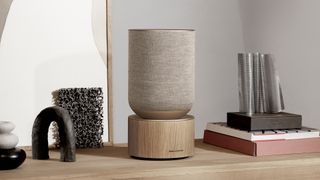
B&O Beosound Balance review: price, release date & features
The Beosound Balance was released in March 2020, for the price of £1,750/$2,250. You can actually order it with or without Google Assistant capability, though there's no price difference (and you can always choose to disable it if you get the version that has it).
Amazon Alexa support is also due in the future, but we don't know when, and trying to predict these things in current circumstances is pointless, so we'll judge it as a Google-only device for now. If you're curious about the difference we've got a guide to Alexa vs Google Assistant.
It's a standard Google Assistant speaker in the sense that it has microphones built-in, and can be set to always listen for the wake word – say "Okay Google" and then ask a question and you're away. It also has Chromecast streaming built in, which isn't a guarantee for all Google Assistant devices when made by a company other than Google, so it's good to see it here.
There's Apple AirPlay 2 support too, which as been standard for B&O's Wi-Fi speakers for a long time. You can also play to it over Bluetooth 5.0, or plug in via good ol' line-in (which doubles as an optical connection).
Basically, getting your music into it is no problem at all, and once it's there, it's treated to a delicious 650W of amplifier power for seven speakers drivers inside.
You've got one 3/4-inch tweeter, two 3-inch full-range drivers, two 2-inch full-range drivers, and two 5.25-inch woofers for bass.
The configuration is interesting: the Balance is designed to sit happily on a shelf with a wall right behind it, and the speakers are aligned to take advantage of this. The tweeter and two smaller full-range drivers face forward, while the two larger full-range drivers are angled at the rear, for spreading ambient sound into the room.
The woofers sit below all this, with one in the wooden base of the Balance pointing upwards, and one at the bottom of the fabric section pointing down, in direct opposition to each other. This is often known as a 'push-push' configuration, and is a neat trick seen a few high-end speaker systems.
The point is to stop unwanted vibrations from the woofers transferring elsewhere in the body of the speaker, and into the surface it's sitting on – stray vibrations tend to interfere with the cleanness of the bass sound. You want the only vibration to be the air that the drivers move, so by having two woofers opposing each other, any vibrations that one would put into the speaker's body is cancelled by the opposing vibrations coming from the other.
The way you know it's working is that you can put your hand on the surface the Balance is playing on, and feel almost nothing, even with the speaker pumping out sound next to you. That's not the case for Apple's HomePod, for example.
These drivers are all paired with B&O's advanced signal processing tech, which enables you to choose a few different modes for the sound: 'Optimal' is obviously implied be the default, and directs most sound forward; 'Lounge' produces a more 'relaxed' sound and spreads it more evenly around the room; 'Speech' is obviously optimised for that; 'Party' makes things more energetic and spreads it around the room.
The Beosound Balance also runs active room compensation, so wherever you put it, it will listen to its own sound and tweak it, because the materials and locations of other objects nearby will affect clarity, which it can compensate for.
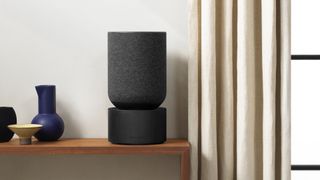
B&O Beosound Balance review: sound quality
It probably won't surprise you to learn that the Beosound Balance sounds fantastic. As you would hope given the price, it is the best-sounding smart speaker so far, though not by much of a margin.
Before we talk about the sound, we need to say that the audio profile on the Balance can be shifted pretty drastically. Not only are there the settings we talked about above, there are also treble and bass adjustment options (though in the case of bass, the effect wasn't that pronounced). But there's also the ability to tweak these preferences by moving a point on a four-way graph, shifting from 'Relaxed' to 'Energetic', and also from 'Bright' to 'Warm'.
And then there's the well-hidden yet possibly essential 'Loudness' switch. Oh, we'll come to that.
What this all means is that while we'll talk about how the Balance presents out of the box, it's possible to heavily adjust the sound to your taste.
In the Optimal mode (in which the speaker is set totally central in the graph mentioned above), what's immediately clear is that it's a naturally bright and fairly neutral sound, with upper-mids and trebles standing out from the rest of the soundscape especially clearly. Voices are lifted impressively beyond instruments, and small high-pitch details are delivered with excellent clarity.
The mid-range is again detailed and can take layered music well without muddying it, though we find it just a little lacking on warmth in this mode, but that's preference rather than a flaw.
For music focused on the mid-range and up, it's the best speaker we've heard at this kind of size. Strings, horns and vocals elevate themselves so clearly out of the mix, but still stay natural rather than turning harsh to get them there. This makes it especially appealing for a lot of classical and instrumental music.
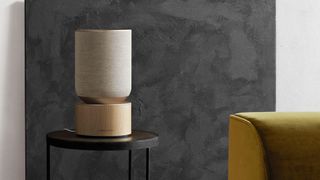
However, the bass is surprisingly low-impact, especially for something with two woofers. It's absolutely there, and it's rich and slick, but it's just not very deep.
This is notable even when we switch to Party mode, in which the tone of the speaker shifts towards the 'Energetic' part of its little graph. This immediately adds meat and warmth to the mid-range, but without stepping on the treble at all, which maintains its loftiness and detail.
This mode also switches to spreading the sound more evenly around the room, and immediately makes the soundstage feel wider and more open too (though don't expect to hear anything stereo-like from the one speaker).
This was our favourite way to listen to the Balance, and suits most genres of music nicely… but we still felt the lack of bass compared to the Apple HomePod in particular, which we had on the same shelf for comparison, as our current ruler of the genre.
Here's the thing: the bass that's there is handled utterly impeccably. It's so controlled, like a rally car driver using power and precision to smoothly hit every mark through a course.
But like our metaphorical rally driver, it almost seems to skim along the surface, with only the amount of traction that it requires. You can’t fault the way it drives, but every often you’d like to see it throw up a bit more mud; to really punch at you with some low end. There’s no enough thump; it doesn't go guttural.
We know lots of people prefer less bass, and it's not always thought of as a very 'hi-fi' thing, but bass is a huge part of high-end listening, even for just instrumental tracks. A real piano has a sound beyond just the note, of the vibration humming through the whole frame of the piano, and the upper-heavy default mix doesn’t replicate this. It’s the same for acoustic guitar: a real guitar sound is a low tone from the cavity and the wood as well as the higher noise of the strings, and the Balance doesn’t replicate that as well.
Even after playing with the bass adjustments, we were ready to say that it's just a factor of the speaker, and that lots of people won't mind anyway…
… but then we noticed the 'Loudness' switch.
This says it's designed to boost bass and treble at lower volumes, and we were doing most of our listening at around 50%, but hey – why not give it a go?
The change was immediate. It still can't punch quite as low as the HomePod (the amount of bass that thing puts out is just bonkers, to be fair), but it finally produced bass that gave you a reaction in your diaphragm for songs that really kick the low end, and this is while still keeping that mid and treble just as lifted and clear.
50% is not 'lower' volume, though! This is hidden away in a 'Sound settings' section, along with the ability to choose things like the sensitivity of the line-in, where few people will ever look – why this is, we cannot imagine.
We'll briefly mention the other preset sounds here: Speech does what it's means to, but feels generally unnecessary to go the hassle of switching to; Lounge just sounds like an elephant sat on the musical, crushing all the bounce and brightness from it, and we're not sure what it's for.
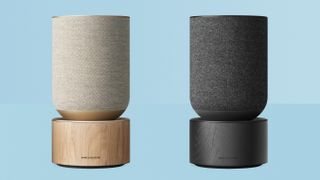
B&O Beosound Balance review: design & usability
It's a looker, no doubt about it. If you find the lamp-like design slightly odd, we can't really argue with you, but we like how it makes the shape a natural thing to see on a sideboard.
There are two finishes: Natural Oak and Black Oak. Natural Oak has a grey/faint beige acoustically transparent cloth on the upper half, with a gold top, and a light oak base; Black Oak has charcoal fabric and black oak base, and a black top.
We prefer the former, but it's all about the aesthetics of where you'll likely place it. there no price difference between the two finishes, as there is with some finishes of B&O's Beosound Stage soundbar.
On top of the unit is a slightly concave panel that includes some touch controls, and these light up automatically when you approach, which is always a nice feature.
You can use these buttons to trigger presets created in B&O's app, but they also include your standard skip/play/pause options. For volume control, the entire outer ring of this panel functions like a touch dial – just run your finger around and a series of lights will rise or fall to show the volume change.
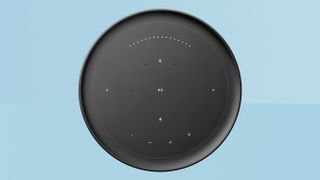
When you trigger Google Assistant, four lights come up within the row that normally shows volume, which is a neat way of including Google's little branding touch.
There's a mic button for manually triggering Assistant, and there's also a hardware switch to disable the mics on the Balance's underside, if you prefer.
The mics prove very capable, hearing our requests as well as any other smart speaker we've tried, even over loud noise. Some third-party speakers are weaker than Amazon/Google devices in this regard, but it worked excellently here.
Setup is easy: the B&O app walks you through getting the speaker online, and then chucks you over to the Google Home app for setting up Assistant. Both are smooth experiences.
The B&O app itself is perfectly understandable, in that it's easy to select your device, and then your main options are presented right up front, such as changing presets. It's maybe a bit over-designed aesthetically, though: the colours used on the presets are confusing at first look, for example.
There are some thoughtful settings to tweak when you dig deep deeper into the menu too, such as setting a default volume level, and a maximum volume.
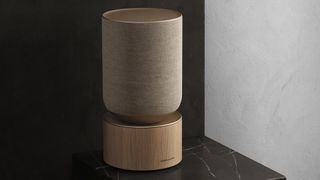
B&O Beosound Balance review: Verdict
• See the B&O Beosound Balance for £1,750/$2,250 at B&O's store
The B&O Beosound Balance is the best-sounding and best-looking smart speaker so far, though it's also the largest, and the most expensive by a long way.
We like how customisable the sound is, even if it's a bit confusing initially, and it can be so natural detailed and open that it really lifts your tracks beyond what a smaller speaker can manage.
However, it's not really a revelation for sound quality, and at this price, that's kind of what you're hoping for.
For the closest alternatives, each of the big smart assistant companies makes a music-focused speaker that's excellent, and in all cases you could get two to run as a stereo pair and still spend about a third of what the Balance costs.
The Apple HomePod is the best-sounding cheaper smart speaker, and is great value after a series of price cuts. However, it's strictly for Apple users only, because the only way to play anything on it is Siri or AirPlay 2.
The Amazon Echo Studio is the Alexa option, and does interesting things with 3D audio support (though with limited support, this is still more gimmick than essential feature, at least so far), while also sounding great.
The Google Home Max is the Google Assistant option, in a big beefy speaker that pumps out a big, finely balanced din.
And there's also the Sonos One, which supports both Alexa and Google Assistant, and offers a similar kind of sound profile to the Beosound Balance, elevating the detail in the upper half of music rather than delivering big bass, though it does sound more compressed. If you want to add bass, and get a more open sound closer to what the Balance can achieve, you could buy two Sonos Ones in a pair, and Sonos' new subwoofer (which also uses a push-push system, like the Balance) to add powerful bass, and still spend £700 less than the Balance.
And that's it really: if you want the best sounding single-unit smart speaker, and can afford it, get the Balance – no question, it's a fantastic speaker. But other speakers can give you 90% of the sound quality for 20% of the cost, so do consider strongly what the best value option for you is.



